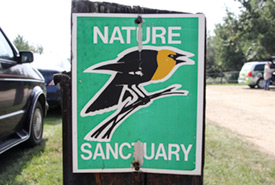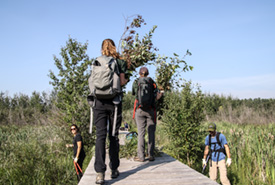Clifford E. Lee Nature Sanctuary

Sign at Clifford E. Lee Nature Sanctuary (Photo by NCC)
At the Clifford E. Lee Nature Sanctuary near Devon, Alberta, the first thing you might hear is the song of the tiny black-capped chickadees as they flit from tree to tree, peeping curiously out from behind the green foliage. Or you might hear the buzz of the grasshoppers hiding in the towering green grasses that line the boardwalk.
The Clifford E. Lee property is a Nature Conservancy of Canada (NCC) conservation agreement property, currently owned and maintained by Ducks Unlimited Canada (DUC). The property’s three-kilometre loop through wetland and wooded ecosystems is perfect for a 30- to 60-minutre stroll.
The property is only a half-hour drive out of the hustle and bustle of downtown Edmonton and close to NCC's popular Bunchberry Meadows property. Within minutes of starting your walk, you'll leave your troubles and the city noise far behind.
Ecosystem changes
Over the last several decades, the landscape around the sanctuary has changed dramatically. Ross Curtis, head of restoration at DUC, has done important work to help maintain the area. In the 1980s, the entire area was a wetland as far as the eye could see. A boardwalk over the water was built to help visitors navigate the three-kilometre loop. Today, the wetland has retreated dramatically, which can be seen from the boardwalk as you begin your walk.
Ross says that this retreat is due to the declining amount of precipitation in the area, which in turn has dramatically changed the area's water table. He says that some of this is attributed to natural changes and overuse of the aquifer in the area, but is in large part a result of global climate change. The retreating wetlands have also resulted in changes in the fauna and flora.
Plant and animal species
As you walk along the boardwalk, be sure to look down at the ground along either side of you for some pink plant surprises. During the summer months, look for the telltale fireweed flowers in bloom as well as the penny-sized rosehip buds growing on the many wild rose plants on the property. There are also several kinds of fungi, including bracket fungi and morels, which have a hollow stem and a cone-like plant. You can look, but please don't pick or eat them!

Conservation Volunteers keeping the boardwalk clear at Clifford E. Lee Nature Sanctuary (Photo by NCC)
If you’re lucky, you might hear or see several species of wetland birds, including horned grebe and red-necked grebe, whose call is said to sound like laugher echoing around a lake. Yellow warbler, pileated woodpecker and common raven have also been seen on this property, as well as black-capped chickadee. Canadian tiger swallowtail can be seen in both its caterpillar and butterfly form, and it tends to be found in wooded areas where they eat poplar and willow trees.
Take a trip!
Take some time soon to immerse yourself in this beautiful green space. See how many of species you can spot on your next trip, and don't forget to bring your camera!
Click here for directions to Clifford E Lee Nature Sanctuary.




